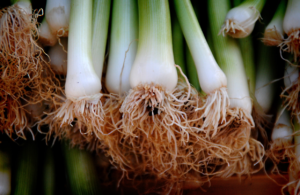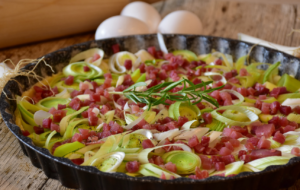Foraging is becoming more popular as people turn to sustainable living and reconnect with nature. One of the most rewarding activities is foraging edible wild onions, which are not only versatile but also delicious. When foraging edible wild onions, it’s crucial to identify them correctly to avoid confusing them with dangerous poisonous twins like Death Camas and False Garlic. This comprehensive guide will teach you everything about foraging edible wild onions, from safe identification and harvesting to preparing them for your meals. Enjoy the process of foraging edible wild onions while staying safe and sustainable.
In this article, we’ll uncover how to confidently spot wild onions, differentiate them from poisonous twins like Death Camas, and explore the best ways to harvest and use them. Read on to sharpen your foraging skills and avoid harmful mistakes in the wild.
What Are Wild Onions?
Wild onions (part of the Allium family) are common plants that grow in a variety of environments, from meadows and fields to forests and even suburban lawns. With over 100 different varieties, these plants have long been foraged by ancient cultures and are now enjoying a resurgence in popularity. The unmistakable flavor of onions or garlic makes them an easy target for foragers who want to spice up their meals.
Key Identifiers of Wild Onions:
- Aroma: All parts of an edible wild onion will smell distinctly of onion or garlic.
- Bulbs: They have small, oblong bulbs that vary in size but are much smaller than the onions you buy in the grocery store.
- Umbel Flowers: The plants produce umbrella-shaped clusters of small flowers, which typically bloom between July and November.
While these characteristics might help you spot an edible wild onion, the real challenge lies in avoiding plants that look similar but are, in fact, highly poisonous. For example, plants like Death Camas and False Garlic are often mistaken for wild onions, leading to dangerous consequences if ingested.
Common Edible Wild Onion Species
There are several species of wild onions that are safe to eat. Understanding their unique characteristics is key to foraging safely.
1. Allium Canadense (Meadow Garlic)
- Appearance: Green, succulent leaves with flowers that can be white, pink, or purple.
- Distinguishing Feature: Leaves form a slight U-shape along the mid-vein, making them difficult to fold.
2. Allium Oleraceum (Field Garlic)
- Appearance: Thin, thread-like leaves with bulbils forming on the stems.
- Distinguishing Feature: Rapid spread in fields and meadows, often confused with grass.
3. Allium Vineale (Crow Garlic)
- Appearance: Chive-like leaves with smooth, waxy texture.
- Distinguishing Feature: Thin, hollow leaves that feel similar to common chives.
For those looking to learn more about how wild onions were cultivated and used throughout history, check out the History of Onions.
Poisonous Look-alikes to Watch Out For

While many wild onions are safe to eat, they have some highly toxic doppelgängers that you should be aware of before you start foraging. Ingesting these plants can lead to severe symptoms, including nausea, vomiting, and in extreme cases, death.
1. Death Camas (Zigadenus spp.)
- Symptoms of Poisoning: Vomiting, abdominal pain, paralysis, and death.
- Identification: Does not have the characteristic onion smell. Flowers grow in tall columns rather than clusters at the top of the plant.
2. False Garlic (Nothoscordum bivalve)
- Symptoms of Poisoning: Mild to severe gastrointestinal upset.
- Identification: Looks very similar to wild garlic, but it lacks the onion scent and has thinner, grass-like leaves.
3. Lily of the Valley (Convallaria majalis)
- Symptoms of Poisoning: Highly toxic, especially to children. Can cause cardiac problems.
- Identification: Lacks onion smell. Its pretty bell-shaped flowers make it stand out, but young plants are easy to confuse with wild leeks.
When foraging, always perform an onion aroma test. If the plant doesn’t smell like onion or garlic, do not consume it! To dive deeper into recognizing these plants, visit resources like Gardening Under Grow Lights.
How to Harvest Wild Onions Safely
Foraging wild onions is more than just knowing where to find them; you also need to ensure you’re harvesting sustainably. Since these plants rely on natural propagation, ethical harvesting ensures that they’ll continue to thrive for future foragers.
Best Practices for Sustainable Harvesting:
- Don’t Overharvest: Only take about 10% of a patch, leaving the rest for future growth.
- Focus on Greens: Cut the green stems at the base, leaving the bulb intact to regrow.
- Avoid Digging Up Entire Bulbs: Digging up the bulbs removes the plant permanently. If the species is invasive, pulling the bulb may be acceptable, but otherwise, focus on harvesting the greens.
It’s also important to avoid areas that may have been sprayed with pesticides or fertilizers. While wild onions are tough and can grow in a wide variety of environments, chemicals can make them unsafe for consumption.
How to Use Wild Onions in the Kitchen

Now that you’ve safely foraged your wild onions, it’s time to put them to good use. These versatile plants can be used in place of scallions or bulb onions in most recipes.
Raw and Cooked Options:
- Raw: Add fresh wild onions to salads or use as a garnish for soups.
- Cooked: Sauté them as you would regular onions or use them in stews, casseroles, or stir-fries.
- Pickled: Preserve wild onions by pickling them for use later in the season.
Each species of wild onion has a slightly different flavor profile, so experiment with different varieties to find your favorites. Whether you prefer a subtle onion flavor or a stronger garlic punch, there’s a wild onion for every dish.
Potential Health Benefits of Wild Onions
Foraging wild onions doesn’t just add flavor to your meals—it can also have health benefits. Rich in vitamins and minerals, these plants offer more than just great taste.
If you’re interested in preserving other foraged foods, check out the ultimate guide to pickling for everything you need to know about pickling your foraged find
Health Benefits Include:
- Nutrient-Rich: High in vitamin C, folic acid, and potassium.
- Antioxidant Properties: Helps fight inflammation and boosts the immune system.
- Heart Health: Similar to garlic, consuming wild onions may improve cardiovascular health.
In traditional medicine, wild onions have been used for centuries to treat colds and respiratory issues. Adding them to your diet is a simple and delicious way to boost your overall health.
Frequently Asked Questions (FAQs)
1. When is the best time to forage for wild onions?
The best time to forage is during spring and early summer when the plants are most tender and flavorful. You can also find them during the fall after they regrow from dormancy.
2. How do I avoid mistaking wild onions for their toxic look-alikes?
Always perform the aroma test. True wild onions smell like onion or garlic, while their poisonous look-alikes do not.
3. What parts of the wild onion are edible?
All parts of an edible wild onion—the bulb, stems, leaves, and flowers—are edible.
4. Can I grow wild onions at home?
Yes! You can cultivate wild onions in your garden, especially if they are native to your area. Make sure to plant them in a spot with good sunlight and well-drained soil.
Conclusion
Foraging for wild onions is an exciting and rewarding activity, offering a unique way to connect with nature. However, it’s essential to distinguish them from their dangerous poisonous twins. Always rely on the tell-tale signs—especially their strong onion or garlic smell—to ensure you’re harvesting safe, edible plants.
By following the steps in this guide, you can confidently forage wild onions and avoid harmful mistakes. Happy foraging!
